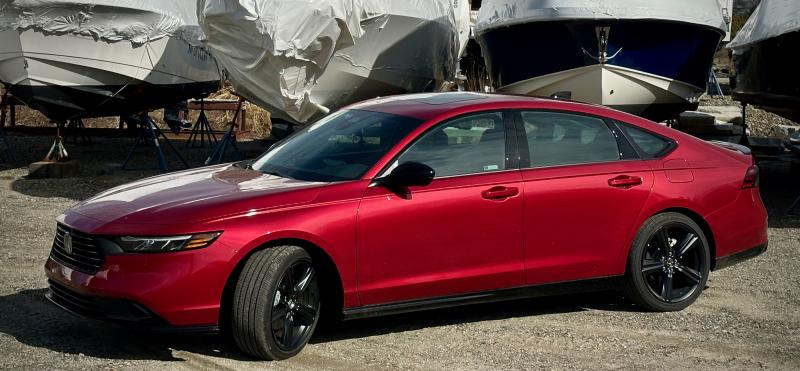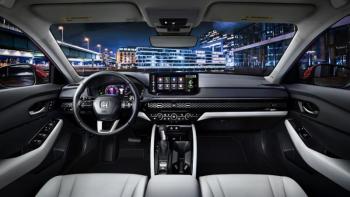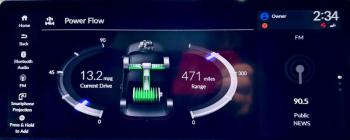Honda Accord Hybrid Sport
Last week’s CR-V and this Accord Sport both have Honda’s new so-called two-motor hybrid system. Two electric motors, that is: One of them helps drive the wheels and the second one is a generator dedicated to recharging the first one’s batteries. Dividing these tasks, says Honda, provides more efficiency and better response.
But these are hybrids, not pure EVs, so there’s a third motor, too: a 2-liter inline 4-cylinder that burns gasoline. Altogether, the total system output is 204 horsepower and 247 pound-feet of torque.
These aren’t big numbers, but when pulling away from a stop, the electric motor gives this Accord (and the CR-V—all gas-electric hybrids, in fact) an instant shot of torque, for extra acceleration. Then, as speed builds, the internal-combustion engine begins to take over. To save gas, whenever possible the electric motor drives the car all by itself, but most of the time the gas and electric motors work together.
The first hybrid car in America was the 2000 Honda Insight. What made this technology possible was an onboard computer powerful enough to reconcile all the different aspects of driving—acceleration, braking, cruising, coasting, idling—with an array of variables such as the gradient of the road, the weight of the vehicle, the driver’s urgency, even the air temperature, the friction of the tires, the condition of the pavement, head- and sidewinds and other indirect factors.
Balancing all this information, the computer decided from moment to moment which motor would do how much work, and how and when to divert some energy to recharging the electric batteries. Today, 23 years after that first Insight, with orders of magnitude more computing power available, we would expect hybrid cars to be that much smoother-operating and more pleasing, and maybe even more efficient.
In fact, they are, and there are presently no better examples of this than these two Hondas, where it’s about impossible to discern any of the hiccups of early hybrids: The transitions from gas to electric power, and electric to gas, are invisible; no more stiff regenerative brakes or eerily light steering; and they certainly don’t feel like flimsy ultralight aircraft.
Almost the only way we can tell what’s going on under the hood now is by calling up the Power Flow page on the touchscreen, which shows us, in a nifty real-time pictogram, where the power is coming from and the miles per gallon, as well as the status of the battery pack and when it’s being recharged. Honda expects two-motor hybrids to account for half of Accord sales.
Both the CR-V and the Accord also come with continuously variable CVT automatic transmissions, but the CR-V shifter has a “B” setting that increases the regenerative braking—slowing the vehicle by the friction of making the wheels turn the generator—while the Accord driver can use paddles on the steering wheel to select more braking and battery regeneration by “downshifting.” Same system, but different approaches that suit each vehicle’s nature, utility or sport.
Along with this Linear Shift Control, the hybrid Accord also offers Normal, Sport and Econ drive modes and an Individual setting that lets the driver mix and match the steering feel and drivetrain and cruise-control response. Every Accord, no matter whether leather-lined or cloth-trimmed, hybrid or gas-only, comes with the Honda Sensing suite of driver-assistance and safety technology.
Every Accord also comes with torque vectoring, which sends extra power to the outside driving wheel in a corner. This plus the Accord’s inherent stiffness and near perfect suspension lets the car slice and dice a twisty secondary road at astonishing speeds.
This is the 11th generation of the Accord, which Honda says has been the best-selling car (not truck or SUV) in America for the past 50 years; and for more than 40 of those years Accords have been manufactured in the US. Five decades of evolution have made the Accord exceedingly driver- and passenger-friendly; and this one has all of the benefits and none of the old flaws of hybrid propulsion and front-wheel drive. They don’t all have to be SUVs, and the Accord is a brilliant example of why.
The Accord lineup begins with the LX trim at $28,390 (including destination fees) and moves up through five more levels to the Touring Hybrid, which starts at $38,435. Our mid-pack Sport Hybrid stickered at $31,895 and, with special paint and destination fees, came to a total of $33,445. Against today’s average new-car price of about $48,000, this feels like tremendous value.
Next week: The Honda Pilot Trailsport

































